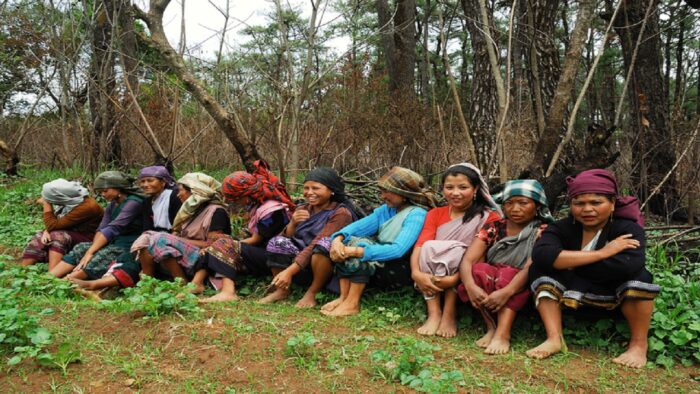Abstract
Ecofeminism is an ideology as well as movement that encompasses two-fold objectives, the first one is empowering women and the second is protecting environment. The idea is a unique blend of ecology and feminism that aims to shield the natural environment by emphasizing the prominence of women in protecting the nature and relating with nature in a better way. It talks about the common strand of domination and patriarchy which subjugates both women and nature. In the first section of the paper, the common grounds of exploitations will be explored and views of some prominent eco-feminist thinkers will be looked into deeply. The second section will examine the role of women in Indian context, their religious activities are not isolated from cultural, domestic or larger religious realms, and all these activities are intertwined within the realm of nature. Religious practices articulate our value system which translates into socio-cultural behavior. These are no doubt deeply entwined in the fabric of our daily lives. It plays a cardinal role in shaping our attitudes and approach towards others beings. Women are seen to have more knowledge about earth systems than men thus making them better qualified as experts in handling the environment. The literature and practices of Vedic times have highlighted these aspects in religious texts. It will also explore the significance of the idea of ecofeminism which is visible in the most prominent environmental movements in India, namely, Chipko movement and Narmada Bachao Andolan, the contribution made by women in these movements is indispensable and these are considered as ecofeminist because the preservation of nature and environment and ensuring economic equity and social justice for women were two major concerns of the participants.
Introduction
Ecofeminism is an ideology as well as a movement that encompasses two-fold objectives, the first one is empowering women and the second is protecting the environment. The idea is a unique blend of ecology and feminism that aims to shield the natural environment by emphasizing the prominence of women in protecting nature and relating with nature in a better way. Ecofeminism or environmental feminism can very basically be defined as a conceptual and theoretical framework which attempts to draw upon a common line of thought between the oppression of women and the domination of nature and how this relation between the nature and women further furnishes a model which can help us to address both the issues of women and ecology in a coherent whole of ecofeminism. Ecofeminism critically recognizes that it is the undefeated presence of patriarchy and its manifestation in various forms in our cultural, social and economic being that has resulted in the devaluation of both women and nature in their association with each other. Recognizing these relations and similarities, ecofeminists have come up with different thoughts and interpretations to construct it as a social movement which revises and reclaims both nature and women as forces to fight patriarchy and challenge its institutions which have in turn sanctioned this subjugation of nature and women in the garb of science and reason.
My attempt in this paper would be to first highlight the different ways in which ecofeminism has been conceptualized by some prominent ecofeminists as all of them have collectively based their theories on the common ground of recognizing the connections between the subjugation of women and nature though they have defined and interpreted these connections differently, viewing them from different lenses, of either history, language, philosophy, spirituality etc. I believe it is only after examining these various stances of ecofeminists that we can define ecofeminism more appropriately as a whole of varying positions unified by one common idea. As, Karen Warren says “just as there is not one version of feminism, there is also not one version of ecofeminism”.[1] We need to understand how different feminists with liberal, Marxist, radical, socialist, etc. leanings define ecofeminism differently. Recently, we have seen this concept is gaining popularity all over the world, the movement such as the Chipko Movements in India, the anti-militarist movement in Europe, and US Greenbelt movement in Kenya, all are counted as ‘Ecofeminist’ movements because women have played a major role in initiating and managing these movements.[2] Secondly, in this paper, I will try to study the role of women in popular environmental movements in the context of India and try to unravel if there is any connection of women with the environment.
The term ‘ecological feminism’ was first used by French thinker Francoise d’Eaubonne in 1974, though ecofeminism as a social and academic movement came into prominence in the mid 1970s and 1980s; a period which was witnessing the second-wave feminism and the green movement bringing the concerns of women and environment to the forefront. Francoise d’Eaubonne argued that women have the potential to bring an environmental revolution, in her work ‘The Time for Ecofeminism’, she claimed that in order to preserve the nature and planet for the future, there is a need to take the authority away from male otherwise the future of humanity and environment will be in threat. She says, “The planet paced in the feminism will flourish for all.”[3] Ynestra King is another well-known successor of Eaubonne in the field of ecofeminism who developed the notion by deeply analyzing the power and dominance relationship in society. According to her, ecofeminism can be understood as a relatedness of theory and practice which sees the corporate warriors as deteriorators of the earth and this devastation becomes a point of feminist concern. She argues that it is masculinity and patriarchal mentality that tries to overpower women’s bodies and sexuality and use various dominant methods to overpower the nature and its ways.[4]
Ecofeminism is an amalgamation of various social movements, for instance, the Feminist, Peace, and the Ecology movements in the 1970s and 80s. The meltdown at Three-Mile Island in Pennsylvania, where a large amount of radiation was released from the nuclear power plant, forced a large number of women in the US to join together in the first ecofeminist conference – ‘Women and Life on Earth, a conference on ecofeminism in the 80s’ in March 1980 at Amherst, Massachusetts. Ynestra King, one of the organizers of the conference wrote: “Ecofeminism is about connectedness and wholeness of theory and practice. It asserts the spatial strength and integrity of every living thing. For us, the snail-darter is to be considered side by side with a community’s need for water, the porpoise side by side with an appetite for tuna, and the creatures it may fall on with Skylab. We are a woman-identified movement, and we believe we have a special work to do in these imperial times. We see the devastation of the art and her beings by the corporate warriors, and the threat of nuclear annihilation by the military warriors, as feminist concerns. It is the same masculinist mentality, which would deny us our right to our own bodies and own sexuality, and which depends on multiple systems of dominance and state power to have its way.” (King 1983: 10) The struggle for independence and rights of women is necessarily linked to the protection and liberation of nature, from an ecofeminist perspective, the former is considered to be a part of the latter. This link is caused by the overlapping of the problems, the source of problems, and the solutions proposed by both the discourses of feminism and environmentalism.
In this regard, Rosemary Radford Ruether pointed out that “Women must see that there can be no liberation for them and no solution to the ecological crisis within a society whose fundamental model of relationships continues to be one of domination”[5] and hence ecofeminists demand a complete restructuring of society.
Over the years different ecofeminists have interpreted this twin domination of women and non-human others (environment and animals) and their interconnections differently. Karen Warren, a very prominent ecofeminist thinker has discussed eight such interconnections which can be seen to present a broad comprehensive view (but not an exhaustive view), explaining the root causes of this conjunctional domination emanating from the ‘logic of domination’.
As the feminist philosopher Karen Warren points out that eco-feminism is founded on various conceptions of those who are commonly either neglected or underestimated in prevailing discourses. It attempts to provide a global perspective on the role of domination in the marginalization and domination of women and nature. Therefore, an ecofeminist perspective is considered as structurally pluralistic, inclusivist, and contextualist, it stresses the crucial role played by context in understanding and evaluating sexist and natural practices.[6]Warren states that the patriarchal conceptual framework guides the basic values, attitudes, beliefs about self and their surrounding inhabitants, and this justifies their logic of subjugation and domination in general and especially in men–women relationships. She explains that this logic of domination is further extended to nature, animals, and other things in association. The important features of this kind of thinking is, value–hierarchical thinking, ‘up down’ thinking where higher status is allotted to one aspect in relation to other, second aspect is value dualisms where the disjunct is obviously seen as oppositional and exclusive rather than being in a complementary and inclusive role (e.g. historically identified as mind /reason, male /female, body /emotion), the third aspect being logic of domination, and the justification for it.[7]
Though, the movement has gained popularity worldwide, the paper is concerned with these theories and practices evolved in the Indian context, the Chipko Movement and Narmada Bachao Andolan are two major movements that are characterized as ecofeminist in nature. The next section sheds light over the momentum of ecofeminism in India.
(Figure 1: Credit: Dreamstime – Chipko Andolan – Hugging trees in order to protect the trees from commercial timber cutters)
Ecofeminism in the Indian context
The significance of the idea of ecofeminism is visible in the most prominent environmental movements in India, namely, Chipko movement and Narmada Bachao Andolan, the contribution made by women in these movements is indispensable and these are considered as ecofeminist because the preservation of nature and environment and ensuring economic equity and social justice for women were two major concerns of the participants. Vandana Shiva is regarded as the pioneer of the ecofeminist discourse in India who maintains that, women’s contribution was sidelined, but women have always been at the center in solving most of the societal problems and environment protection. Notably, the vision of Vandana Shiva is very much inspired from Indian philosophy and its spiritual aspects widely influenced her arguments.
She says, “Women in India are an intimate part of nature, both in imagination and in practice. At one level, nature is symbolized as the embodiment of the feminine principle, and at another, she is nurtured by the feminine to produce life and provide sustenance.” In her most notable book ‘Staying Alive: Women, Ecology and Survival in India,’ she unfolds two aspects of her agreement, the first one is her interpretation of ‘The Feminine Principle’ that is strongly related to spiritual ecofeminism, Hindu mythology and Indian philosophy. The principle is recognized with ‘Prakriti’ that seeks to nurture and protects the harmony and diversity of nature, as it is the source of all life on the Earth. The other aspect relates to social and political eco-feminism that criticizes patriarchal hegemony and masculine worldview. She also criticizes the mal-development and reductionism caused by western ideology of capitalism and colonization.[8]
Shiva is against the development model put forward by the western technology, patriarchal and colonial projects because these methods are inherently violent and indifferent to the harm done to women and nature. According to her, accepting and practicing these models has shifted us away from the conception which sees prakriti or ‘The Feminine Principle’ as a living and creative process, and considered as merely a passive resource for fulfillment and pleasure. This is indirectly responsible for marginalization and even dispensability of women. The methods of modern development assault women’s knowledge of nature and their dependence on it for ‘staying alive.’[9] The gist of ecofeminism lies in the realization that women are not just the bearers of the blind development processes but also inhere the potential and power for revolution and change. The struggles and actions initiated by women in worldwide environmental movements and in major Indian movements such as the Chipko Movement of the 1970s in the Garhwal district of Himalayas–where women protected and contributed for the regeneration of the forest show that there is necessarily an interconnection between women, nature and development.
The Chipko movement
The Chipko movement is one of the most noted and successful ecological movement, it was a form of non-violent protection that took place in the Himalayan regions of India. As the name suggests, the central idea was to embrace or hug the trees in order to protect the trees from commercial timber cutters. There were conflicts between the villagers and the government because of the permission granted to cut the trees for business which was unacceptable and inconvenient to residents of villages, the movement spread to other areas as well. The women’s participation was clearly visible in the protest; they worked along with men and sometimes against men to protect the trees. They were more inclined towards the long term benefits of saving the trees and natural environment rather than short term commercial benefits. They understood that trees are productive enough to fulfill needs but not the greed of humans. The involvement of women broadened the scope of the movement, and social issues such as domestic violence, women’s representation in village councils, male alcoholism also become part of the struggle. This shows the interconnectedness between women, nature and human survival and subsistence. The Chipko movement is discussed a lot by thinkers like Bandhyopadhyay (1987), Shiva (1987 & 1988) as one of the greatest representation of special relation between women and nature.[10]
Involvement of women within these movements helped to bring out a revolution for the status of women themselves, their participation turned out to be effective in saving the forests also. Their active participation showcased an innovative power of women and the success helped them to gain self-confidence and explored ‘a subtle interplay of power and authority’ because in day to day life women have to handle the agricultural activities, livestock caring, etc. Women have been ‘source of dissent, alternative ideology and agent of change’ and their responsibility towards nature must influence their participation in nature management as women are the ones who have borne higher workload and efforts to meet the basic needs of family if forests are de-structured.[11]
[1] Karen Warren, , “Ecological Feminist Philosophies: An Overview of the Issue”, Ecological Feminism, Routledge 1994.
[2][2]Manisha Rao, Ecofeminism at the Crossroads in India: a Review, 20 (2012): 124-142..
[3][3]George Matthew Nalunnakkal, “Towards an Organic Womanism: New Contours of Ecofeminism in India.” Journal of Lutheran Ethics, 3 (2003): 1-19.
[4][4]Manisha Rao, Ecofeminism at the Crossroads in India: a Review, 125.
[5]Rosemary Radford Ruther, ’Ecofeminism – The Challenge to Theology’ 1997.
[6]Ibid., 125.
[7]Karen J. Warren, ed., “The Power and the Promise of Ecological Feminism,” in
Ecological Feminist Philosophies (Bloomington: Indiana University Press, 1996), p. 20.
[8]Inga B. Tollefsen, Ecofeminism, “Religion and Nature in an Indian and Global Perspective.” Alternative Spirituality and Religion Review, 2 (2011): 89-95.
[9]Seema, “Ecofeminism and Environmental Movements in India.” International Journal of Current Research, 6 (2014): 4658-44659.
[10]Manisha Rao, Ecofeminism at the Crossroads in India: a Review, 134.
[11]Graduand Passantino, Ecofeminism in India: from the Chipko Movement to the Case of Narmada alley Development Project (Vanice, Italy: Ca’ Foscari University of Vanice, 2016), 70.
Feature Image Credits: dreamstime.com
Watch video presentation of the above paper here:
Disclaimer: The opinions expressed in this article belong to the author. Indic Today is neither responsible nor liable for the accuracy, completeness, suitability, or validity of any information in the article.









